See our Seattle Bike Share Guide for an updated list of bike share companies in Seattle, links to download their apps and a quick rundown on how it all works.
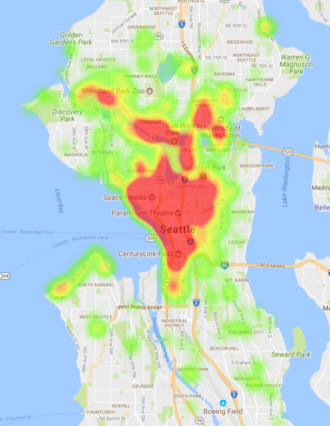
People took 5,008 rides on Spin in the company’s first week operating in Seattle, 60 percent higher than Pronto’s opening week in October 2014 and 300 more rides than Pronto’s busiest week in its two-and-a-half year life (mid-July 2015).
And this is just a taste of Spin’s vision for serving Seattle. The city’s pilot permit limits the company to 500 bikes in the first month, 1,000 in month two, 2,000 in month three and then more after that if all goes well. Spin said in a press release when they launched that they hope to get to 10,000 bikes.
But this week was a great chance to learn about the power of the stationless bike share model. It’s the closest thing to a bike share Pepsi Challenge we may ever get. Both Pronto and Spin had 500 bikes operating essentially exclusively in Seattle, and Spin got more rides. A week isn’t an overwhelming amount of data, of course, and there are still unanswered questions about how the company is going to keep up with maintenance. But at first blush, wow. This stationless bike share thing seems to be off to a promising start. From Spin:
In week one, we’re excited to share that we’ve hit 5,008 rides. Our average ride lasts 16.71 minutes, our top user has logged 20 rides, and an average rider has taken 2.7 trips.
The company focused most of its initial bike drops and redistribution on downtown and nearby areas, since 500 bikes is not enough to cover a wider area very well. But users can ride the bikes anywhere they want. So just about any bike outside the city center got there because someone biked it there from downtown. And people biked Spin bikes to just about every corner of the city.
Outside downtown, the Burke-Gilman Trail corridor and nearby areas obviously did very well. This is an area Pronto never served outside a small section in the U District. Pronto was supposed to expand to Fremont and lower Wallingford shortly after launching, but this never happened. So all you Pronto members who were pulling your hair out waiting for the system to serve Fremont, the Spin heatmap above vindicates you.
The heatmap also shows strong use along Alki, far away from the central neighborhoods where the bikes were initially dropped. I worry a bit about the existing beach cruiser rental businesses on Alki who have been serving the beachside trail for many years.
There are also hubs of rental activity around every Rainier Valley light rail station, especially in the area between Othello Station and Graham Street. Previous bike share efforts were very bearish on the business potential for bike share in Rainier Valley, and we have consistently pushed back against that. Spin is showing that there is demand in Rainier Valley despite the lack of quality bike lanes. The light rail stations are often located an awkward distance from major business districts and residential areas, a little long for a walk but too short to wait for a bus. Bike share is the perfect solution to this problem.
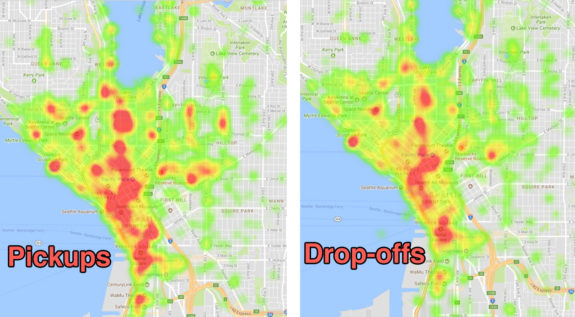
Zooming into the central neighborhoods where Spin has focused its initial drops, you can see that people are taking the bikes, well, basically everywhere. People are little less likely to end a trip up a big hill than they are to start one there, which is no surprise. An analysis of Pronto’s ridership data by Jake Vanderplas showed that for every ten trips downhill, four or five came back uphill.
But the wide distribution of drop off locations further demonstrates an advantage of the stationless model. People are going to all kinds of places, and if you don’t have a very dense network of stations, then you’re simply not serving people’s trips. And if you don’t serve someone’s trip, they aren’t going to choose to use your service. That’s pretty simple.
Below, I overlayed the Spin drop-off heatmap with the old Pronto station locations. The Pronto team didn’t do a terrible job getting close to the hot spots, but the stations are rarely in the middle of the hottest areas. It might look good a map, but in practice this means stations were often just out of view of these epicenters of activity (including transit tunnel entrances). This was a common complaint about Pronto, and it seems that this map backs up those complaints.
But stationless bike share also serves all those yellow and green areas between the red areas, which add up to a good number of rides. Pronto would have needed a lot more stations to effectively serve all the destinations Spin now serves.
And, again, this is just a taste of what the new bike share industry has to offer Seattle. LimeBike is set to launch its 500 bikes by the end of the week, culminating in a kickoff event they’re calling LimeRide all day Saturday (as advertised on Seattle Bike Blog). UPDATE: LimeBike started distributing their bikes en masse Tuesday, so check them out.
And two more companies, VBikes and ofo, have submitted bike share applications to SDOT. If they are approved, they could add an additional 500 bikes each in coming weeks. Then Spin and LimeBike will be able to increase their fleets to 1,000 each August 7. So the current Spin experiment is a mere fraction of the number of bike share bikes the city could have in service just a couple weeks from now.
People still thinking about these companies as just a replacement for Pronto are missing the big picture. If these companies succeed how they think they will, we’re on the verge of a major non-motorized transportation revolution in our city. This is also why so many people can’t figure out how these companies will make money. They don’t yet get the scale these companies believe they can reach. $1 for a ride sounds too cheap. But at a large enough scale, it could add up fast.
The bike share business model is based on the idea that the more bikes there are, the more dependable the service becomes for more trips by more people. So as the companies add bikes, the number of trips should increase at an even faster rate. This increase should continue until some point where adding bikes no longer gains more trips. That’s the city’s saturation point. Nobody knows what this number is, but these companies believe it is far beyond Pronto’s wildest expansion dreams.
And with enough competition, it’s not hard to imagine the price dropping. VBikes and ofo, for example, advertise $1 for an hour, twice as much riding time as Spin and LimeBike offer for the same price.
Then again, Spin says the average trip during week one was just under 17 minutes, so maybe the extra time isn’t such a big selling point. We may be about to find out.
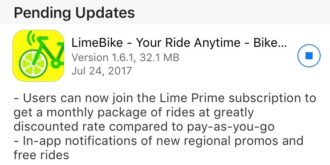 LimeBike’s latest app update also hints that the company plans to offer a membership for heavy users called Lime Prime. So the membership space is another price competition point to watch for.
LimeBike’s latest app update also hints that the company plans to offer a membership for heavy users called Lime Prime. So the membership space is another price competition point to watch for.
With so many companies all jumping in at the same time, it’s going to be fascinating to watch how they jockey for ridership. I’m sure it will be messy at times, and I don’t know how many different companies can successfully operate in the same space. Transportation departments across the U.S. are watching Seattle right now, and the companies know it. Succeeding here could be a path to getting into major markets across the nation.
Any traditional bike share system that hasn’t built out a very dense network of stations should be working hard right now to figure out how to compete. Outside maybe a few extremely dense and tourist-heavy cities like New York, that old $8 for a 24-hour pass pricing model is going to get crushed by $1 rides. Maybe even giants like NYC’s CitiBike are vulnerable.
Of course, this will only become an issue if the companies succeed and grow enough to expand across the country like they are planning. There are a ton of questions left to answer about their ability to keep up with maintenance and gain the level of ridership they think they can reach.
San Fransisco recently protected their recently-expanded public-private system (now called Ford GoBike, a sign that even automobile behemoth Ford sees the money in bike sharing) by passing harsh and limiting stationless bike share regulations that far exceed the regulations on the Ford-sponsored system or even on scooter and car sharing services. Their loss is Seattle’s gain, because both Spin and LimeBike are Bay Area companies who are investing here first instead.
Spin is fixing bugs and building a better bike
Spin’s first week hasn’t been without some hiccups and bugs, which isn’t surprising for any young company offering a new service like this. Readers initially reported issues using the app, especially on Android phones, but at least some of those issues appear to have been fixed. So if you had trouble last week, give it another try.
But most complaints have been about the bikes themselves. The gearing is too high to climb many of the city’s hills without standing, the shifters are sometimes jammed, the brakes aren’t as strong as they could be, the rear only has a reflector instead of a light (legal, but not preferred), and the headlights are flimsy and don’t come on automatically unless switched on (the switch is not immediately obvious, leading some people to think the lights are broken). Also, people have started to steal the seatposts and saddles. For a buck, these aren’t dealbreakers for many people (OK, the headlight and saddle are pretty important), but they are areas for improvement if the service really wants to get wider use.
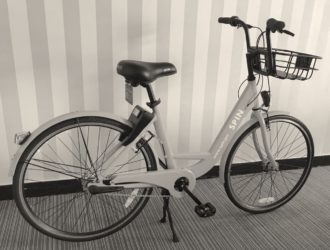
The good news, however, is that Spin has heard these complaints and already has a second generation bike in the works for their August expansion that should address these issues. They also say they will be retrofitting their current fleet. From Spin:
Twelve is our newest Spin bike specifically designed based on your feedback, Seattle. Yes it’s still orange. But among its many upgrades, here’s a couple we’re particularly excited about:
Gearing. For a public bikeshare, what matters most is not the number gear ratios (or “speeds”), but the individual gear ratios themselves and the reliability of the hub. We’ve reduced our gear 1 ratio by at least 25%, in our quest to provide the best gear ratio, whether you’re riding up Capitol Hill or down 2nd.
Center mounted dual kickstands. Our new kickstand keeps our bikes upright and stable between rides.
Lights. Instead of a rear reflector, we now have a nifty new solar-powered rear light! And look forward to an all new dynamo front light, which is even more durable and stays on after you stop. Safety first.
Brakes. Our front and back brakes by Minnesota’s Promax will give you even more stopping power as you zip down slopes.
Twelve hits the streets this August. We’d love your feedback once again, as we work towards the perfect bike together.
Wait, There’s More
August feels like forever, so we’ll be upgrading our current fleet with some of Twelve’s signature parts, starting this week. Our mechanics will be all around town, so drop by and say hi!
This is a very quick response to user feedback. Within a month, they plan to address a huge number of seemingly big issues with their bikes to get them right for Seattle. The ability to be nimble like this is another advantage Spin has over traditional U.S. bike share systems.
Of course, this is a game of startups. It’s impossible to know who will succeed, who will fold, who will buy who and how any of this is going to be working in 6 months or a year. It’s exciting and volatile. And if these companies only get half as far as they think they can, our city is going to need a hell of a lot more safe and connected bike lanes to serve the big increase in biking.
At a time when our streets are more and more clogged with cars, this private bike share movement is the only serious and immediate response to the problem happening right now. It is in everyone’s best interest that these companies succeed. This is one more reason why the city needs to build the Basic Bike Network as soon as possible. Intimidating streets in our central neighborhoods remains the biggest impediment to more people biking there.

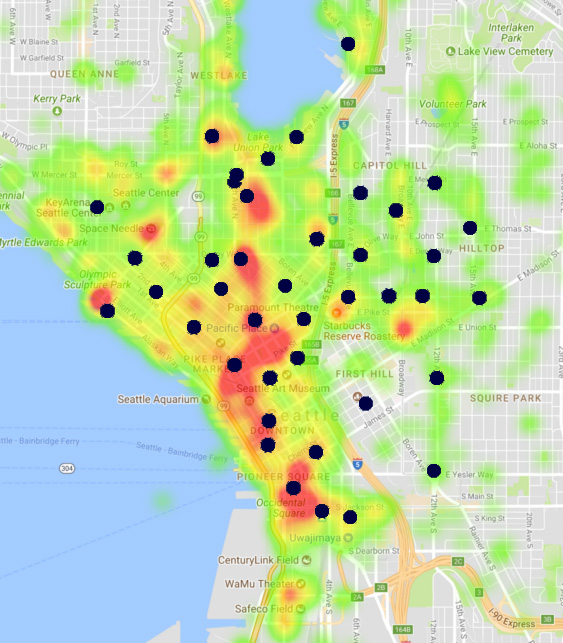







Comments
30 responses to “Spin smashes Pronto ridership in week one, announces improved bikes”
The call for bike share to serve Ballard is definitely also vindicated.
FWIW, from what I can tell, green and light green appear to represent very few trips (perhaps just 2). So, I’m not sure the green in the Rainier Valley represents much more than the early effort by some folks to artificially show demand by biking the bikes to Southeast Seattle on night #1. Hopefully we’ll continue to see some ridership in neighborhood-specific hotspots, such as biking from the Columbia City light rail station to the Columbia City business district.
Interesting patterns:
1. The heatmap fills in red across the Ship Canal, but not at a bridge, from Gas Works to Eastlake (that would be an interesting spot for a bike/ped bridge)…
2. … and leaves gaps along corridors where people certainly travel but don’t stop super often. This is particularly true where grade and road infrastructure creates narrow corridors (pinch points between Eastlake and Fred Hutch, between Fremont and Westlake, around the U Bridge)… but also in industrial “Frelard” and residential Wallingford along the Burke… and in most of SODO, between downtown and the bright spot near Starbucks HQ.
3. That bright spot near Starbucks HQ — there’s no corresponding spot at the SODO light-rail station. Considering the rest of the distribution, people must mostly be riding there from the north. But I’m not going to draw too many conclusions, because I don’t think either of these areas were covered by the initial distribution — it might take some time for patterns to emerge.
4. Fortunately for us all not many people are riding ’em around Green Lake!
The way the heatmap fills in from Gas Works to Eastlake reminds me of this thing from a few years ago, that used sequences of geotagged tweets to figure out what sorts of mass-transit routes, in the abstract, might aggregate the trips that these people were making. And there was this big line essentially running from downtown up Madison to 520, which isn’t something we’ve ever seriously considered building. While obviously geotagged-tweet authors aren’t representative of the population and it can’t be taken as a substitute for real planning, it certainly is provocative in 2017, as Eastsiders protest bus truncations at UW and U District-SLU buses are overflowing. Similarly, the idea of building a bike bridge landing right in the middle of Turtle Cove is pretty provocative…
FWIW while at Starbucks Center last Wednesday I did see one spin bike parked and then a couple of Spin employees dropping bikes off there a little later. Having taken light rail there and back home I can confirm zero bikes at the Sodo station.
This makes me so happy! I look forward to trying out Spin and its competitors.
I wonder if they decided that a solar-powered rear light would be more robust than running a wire to the front dynamo and using a rear dynamo light.
I can imagine those wires being a prime target for malicious mischief. solar taillights will probably be easier to maintain.
Exciting proposed updates from Spin. Thanks for your reporting, Tom! The improved gear ratio customized to Seattle’s needs is a particularly welcome change.
It’s maybe a bit unfair to directly compare the Pronto numbers to the Spin numbers, because Spin is offering free rides and Pronto wasn’t (IIRC). That’s sort of like a Pepsi Challenge where the sip of Pepsi is free, but you have to pay to try the Coke.
(Relatedly, has SDOT sold the Pronto bikes/docks/kiosks yet? I hope we were able to pass those along before launching a program that seems likely to reduce their value…)
@Matthew: While Spin is offering credit for new accounts, even at $1/ride and entirely pay-per-ride, they’re cheaper ($1/ride vs $8/day) and easier (no kiosk) than Pronto ever even tried to be. If Pronto had offered $1/ride or had accepted ORCA cards, they’d at least have had a shot at adoption in the areas it served.
Pronto’s annual charge of $85 was a serious bargain if you used the system all the time, as some of us did.
I wonder if there’s some other difference between launching in July and October in Seattle. Nothing comes to mind, though.
$85 is significant investment for something you aren’t sure about. I can easily throw a few $ at something like Spin to test it. I have ridden spin bikes 4 times so far. Not I have had 15 failures to collect bikes in the same period, either already reserved (?) or something else wrong. This ratio makes it a pain to use regularly. I am curious how they proceed and will give limelight a try too.
+1 for the notion that the Rainer Valley would hop on with more bikes around. I live between Seward Park and Columbia City (Lakewood) and would ride the mile to the train most every time instead of walking down to the station.
I have some hope for this retry of bikeshare. Sadly disappointed today, trying unsuccessfully to use Spin to get from Pioneer Square to 6th & Union in am and back in pm. Map of bike locations is vapor. Not one of over a dozen bikes on map was actually at the location or anywhere on the block at 8:30 am or 5:30 pm. My location was noted accurately, but there was not an orange bike in sight. A few random Spin bikes encountered while walking both directions would not unlock when scanning the QR code. These included bikes parked all day at same spot, so not still “in use”. Nor would the keyboard on the app show up when trying their backup of typing in the bike number — just a spinning wheel. Chat online “usually back to you in a few minutes” took hours for answer that there is an area where the bikes have no reception and you must be in it (from Columbia & 1st to 6th & Stewart??); and advice to update the app (loaded 2 days before and no updates available, using iPhone with up to date OS). Problems:
1. No re-distribution of bikes to downtown from remote locations where not in use >24 hours. Ridiculous lack of bikes where people would logically use them.
2. App fails to locate bikes accurately.
3. App fails to unlock bikes.
4. Slow and inept online support.
5. Obvious lack of on-the-ground advance testing.
I’ll try again in a month if Spin is still in business here. Meantime, if you have the time and appetite for it, go ahead and beta test for Spin. $10 in free rides if you sign up.
I experienced the failure to unlock problem, but updating the Spin app fixed it. Seems like they are pushing upgrades continuously.
I have been at a 15 to 4 ratio for failure to success thus far. I just updated so we will see how it goes this evening.
Pretty negative review here
https://arstechnica.com/business/2017/07/dockless-bike-sharing-lands-in-seattle-and-leads-us-down-unsavory-alleyways/
Sustainability of the model, again, appears to be a concern, especially given the maintenance and helmet law issues.
I’ve ridden the Spin bikes a few times so far, mostly along the Burke-Gilman. Yes, the gearing is too high to climb almost any Seattle hill and, yes, finding a bike at the top of Capitol Hill or Queen Anne is difficult, but for trips between points on the Burke-Gilman trail, the system works great. Advantages Spin has over my personal bikes include a quicker process for starting/ending trips (it takes me at least a couple of minute to lock or unlock a bike at each end of a trip), being able to park out on the street in places where I’d be chicken to park my own bike (e.g. 520/Montlake), a seat that is comfortable enough to ride on for 20-30 minutes without butt padding, and the ability to walk around or bus somewhere else, come back a different way, and not needing to take extra time to pick up the bike I left earlier.
I really hope the system succeeds, although, theft and vandalism are going to be a constant concern.
As to helmet laws, everyone knows that for the system to work, people are just going to disobey them while the cops looks the other way. But, of course, the bikeshare company can’t come out and publicly say this. They have to pretend for the camera like everyone is going to carry helmets around everywhere they go, just in case they want to check out a bike, when, in reality, they know that people who want a ride and don’t have a helmet with them will ride anyway. I think this is fine, as it places the onus on the user to use common sense. For example, if I’m riding without a helmet, I won’t go up or down steep hills, heavy-traffic streets, or ride at all when it’s dark or raining.
As to relative lack of bikes in the Ranier Valley, a lot of that has to do with the lack of flat routes from downtown, where the bikes are seeded. For instance, most of the bikes that got to the U-district probably got there via SLU->Fremont via Westlake, followed by Fremont->U-district via Burke-Gilman. Alki, again, has bikes because the route there from downtown is flat. With no flat route to the Ranier Valley from downtown, the number of bikes around there to ride is going to be limited, unless the company directly seeds some bikes there.
In general, though, I don’t think it’s worth pouring money down the rathole of actively trucking bikes around the city to rebalance them. Even if there’s a chronic shortage of bikes at the top of hills, it’s not like the bikes at the bottom of hills just sit there and never get used – there are plenty of flat trips along downtown, SLU, Fremont, and the Burke-Gilman corridor that bikes at the bottom of hills can and do end up taking. It might be worth offering discounts or free rides to users who are willing to take a bike uphill, but that would be about it.
Free rides when biking uphill is really the easiest thing to do, and I think it would be pretty effective. If your end point is, say, 150ft+ higher in elevation than your start point, you get $1 off the ride, or somesuch. I seem to recall the Paris bikeshare had something like this, except that you could bank the free minutes it gave you to extend future rides beyond the 30-minute max.
[…] suburb are warning drivers not to yield to cyclists and pedestrians at a trail crossing. And Seattle Bike Blog reports that the city’s new dockless bike-share service, financed and operated by a private […]
You have a bike out here on 27th Avenue that has been out on the street for a week now.
9489830. It needs to be picked up before its stolen.
thank you.
Might want to add which block of 27th. Probably a Spin and not Lime as there have been very few Limes.
[…] suburb are warning drivers not to yield to cyclists and pedestrians at a trail crossing. And Seattle Bike Blog reports that the city’s new dockless bike-share service, financed and operated by a private […]
[…] suburb are warning drivers not to yield to cyclists and pedestrians at a trail crossing. And Seattle Bike Blog reports that the city’s new dockless bike-share service, financed and operated by a private […]
If you compared weeks in mid-July using the stats in this article…
Spin: 5008 trips/500 bikes, 1.43 trips/bike/day
Pronto: 4708 trips/500 bikes, 1.35 trips/bike/day
Both examples come with caveats. It was Pronto’s best week ever. It was Spin’s system launch and they were offering free rides.
Also, Spin didn’t have all 500 bikes out for the whole week. They were rolling them out over time. So, another caveat.
Does anyone know what that sort of “P” shaped indicator is on the Limebike app? there’s a bunch along California Ave SW between Admiral and Alaska, but no big juicy lime logos that refer to the bikes. I can’t find an indication of their meaning on the app, their website, etc.
Those are u-lock icons, indicating public bike racks. I find them a little distracting, personally. I like the idea, but you’re not the only one confused about what they mean.
Ooh, thanks! I guess it is still just Spin Bikes out here. Maybe I can take the first Lime Bike to Alki…
I like both the Spin and Lime bikes. I just realized that it might be useful to have both services because with one phone you can unlock one of each bike, so it’s possible to unlock two bikes at a time for a ride with a buddy who hasn’t signed up.
The one big difference is the lime bikes have a much lower first gear and an 8-speed hub. The low gear is great. On the downside, the gearing is too close for my preference, I can barely tell the difference between any adjacent gears, but I’m a big dude who enjoys mashing hard on my BMX and single-speed MTB. The lime bike has a pretty cool saddle hight adjustment, it’s a lever right under the saddle. I wish it went a bit higher, I’m 6’2″.
The lime bike lock plays a cute little tune when it operates. Also, the lime bikes basket turns with the bars, while the spin bike basket is locked to the frame. visually, it’s pretty funky to turn the bars and the basket stays still. The solid tires and short cranks of these bikes feels a little weird too, but overall it’s a good design for casual rides.
There is an orange one on Delridge and Brandon that was left in someones yard and then they must have put it on the outside of the fence and now I see it across the street laying against the tree by the church. It has been in this general location for several weeks. Kind of looks like a dumping stuff in front of people’s property that they have to maintain. There should be approved locations of where they are allowed to be left.